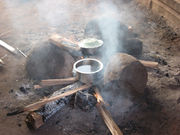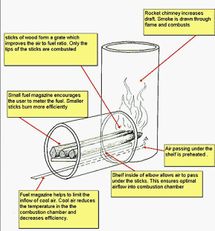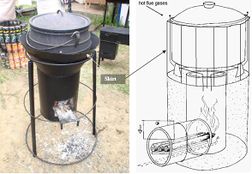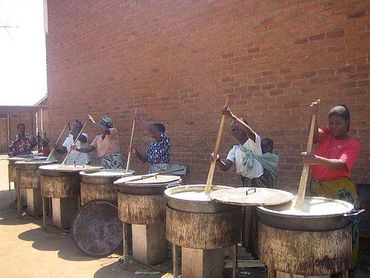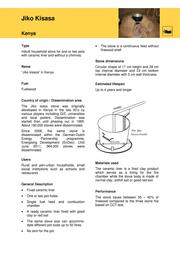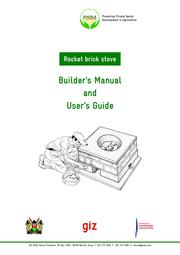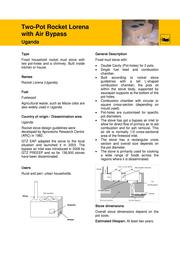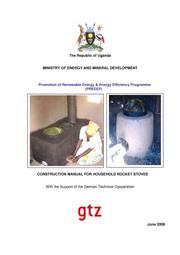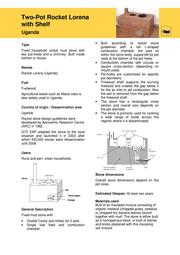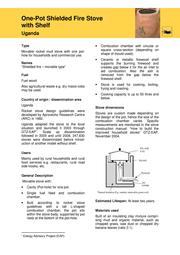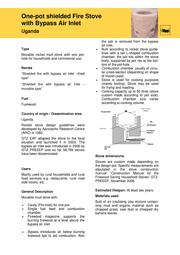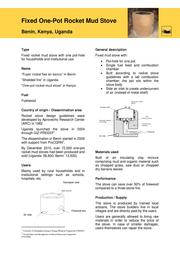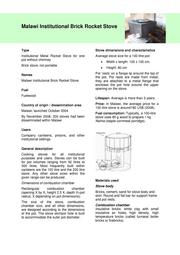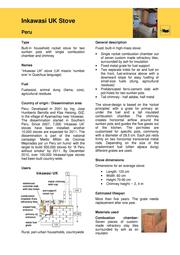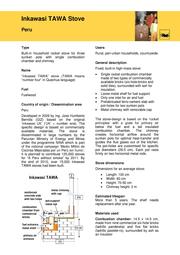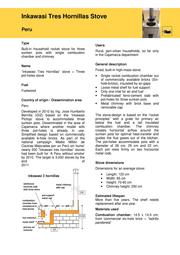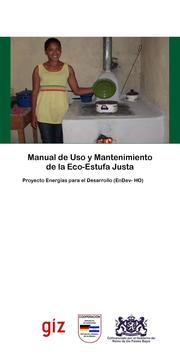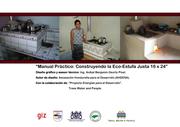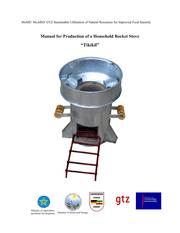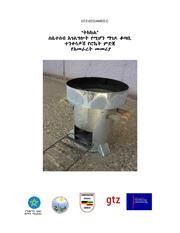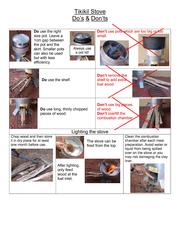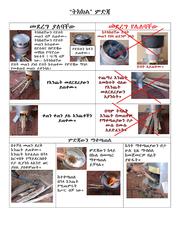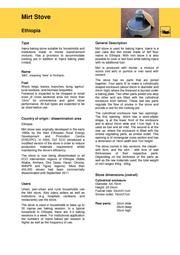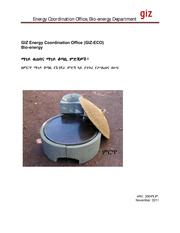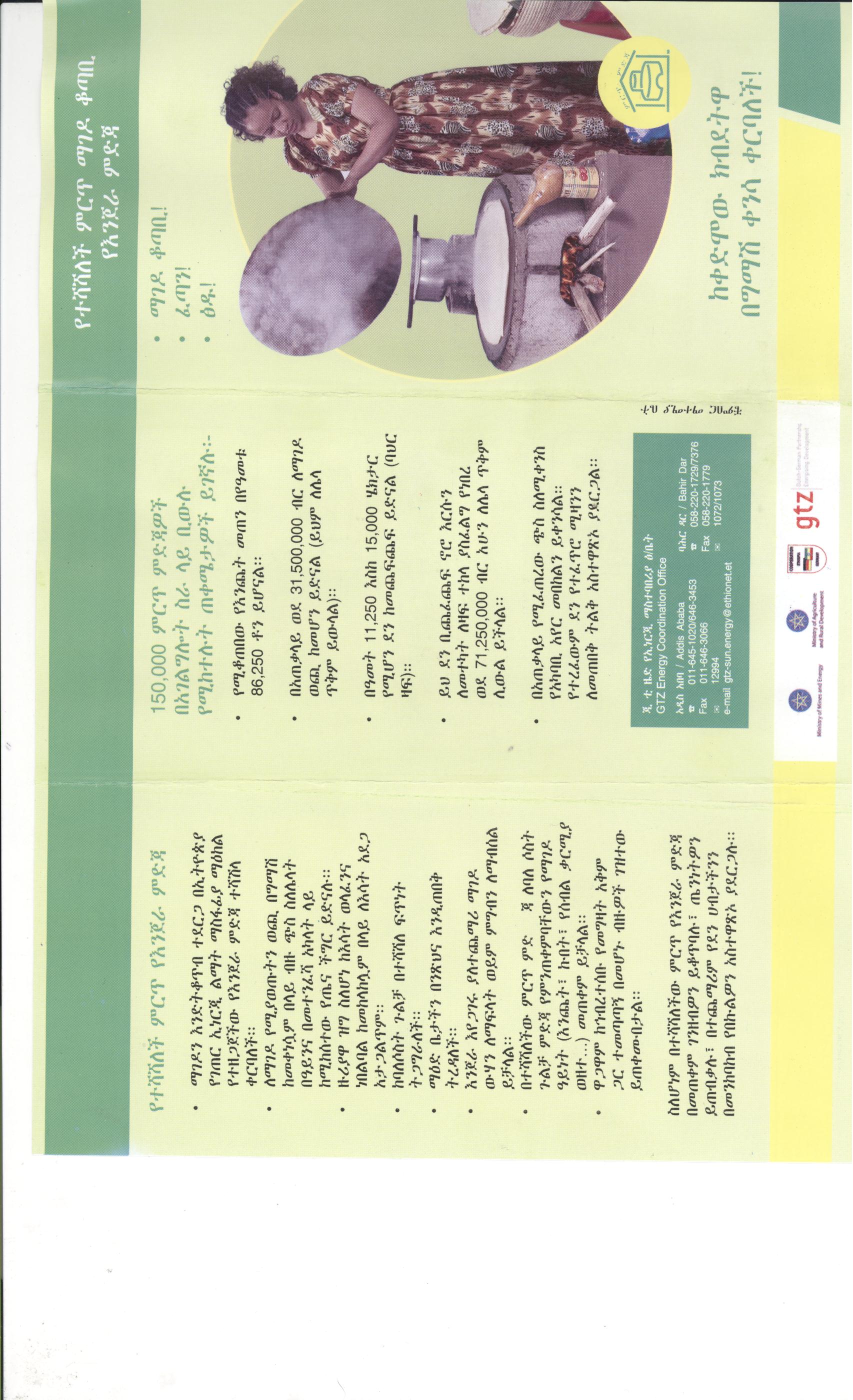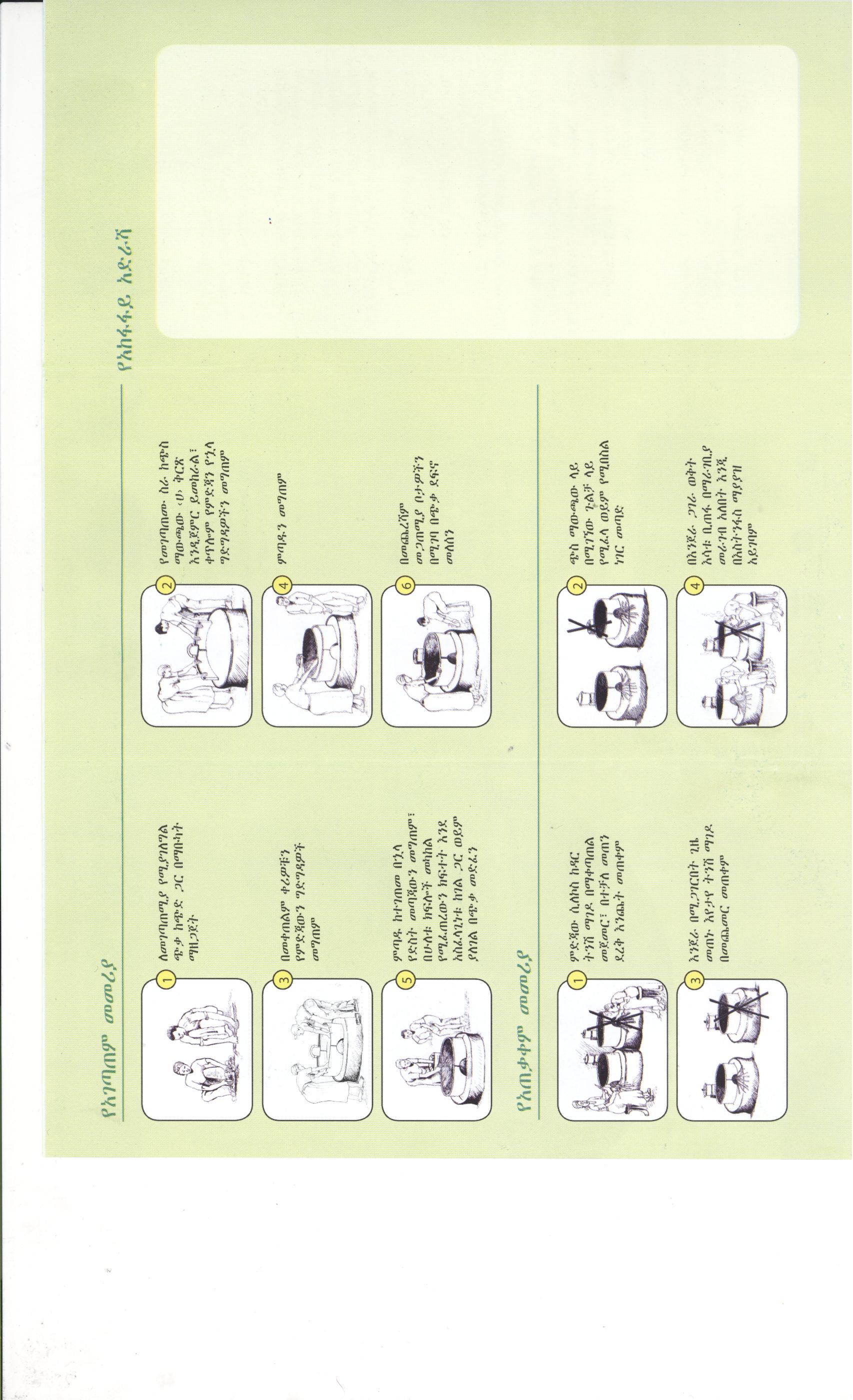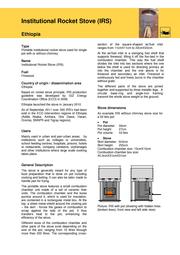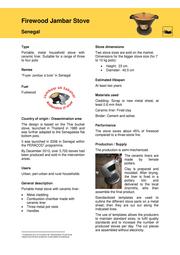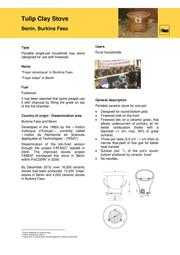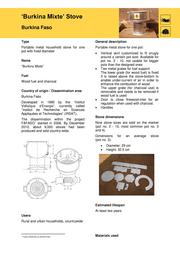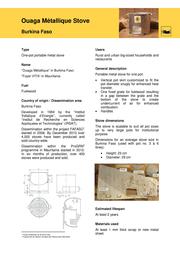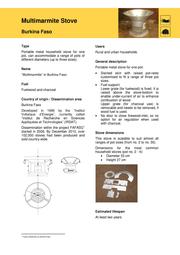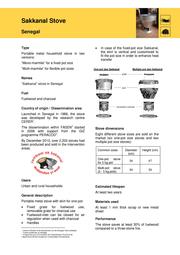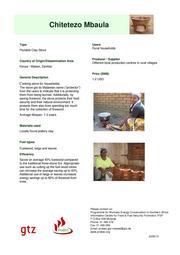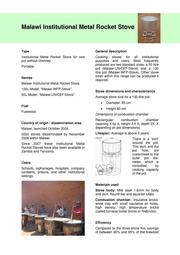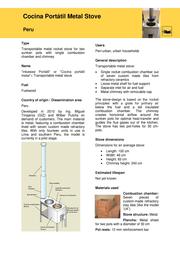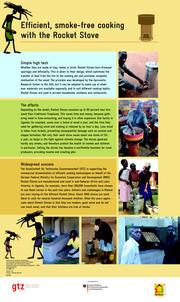Knowledge fuels change
For over a decade, Energypedia has shared free, reliable energy expertise with the world.
We’re now facing a serious funding gap.
Help keep this platform alive — your donation, big or small, truly matters!
Thank you for your support
Difference between revisions of "Firewood Cookstoves"
***** (***** | *****) m (Lisafeldmann moved page Cooking with Firewood to Firewood Cookstoves without leaving a redirect) |
***** (***** | *****) m |
||
| Line 2: | Line 2: | ||
[[File:GIZ HERA Cooking Energy Compendium small.png|left|831px|GIZ HERA Cooking Energy Compendium|alt=GIZ HERA Cooking Energy Compendium small.png|link=GIZ HERA Cooking Energy Compendium]]<br/>[[GIZ HERA Cooking Energy Compendium#Basics about Cooking Energy|Basics]] | [[GIZ HERA Cooking Energy Compendium#Policy Advice on Cooking Energy|Policy Advice]] | [[GIZ HERA Cooking Energy Compendium#Planning Improved Cook Stove .28ICS.29 Interventions|Planning]] | [[GIZ HERA Cooking Energy Compendium#Designing and Implementing Improved Cookstoves .28ICS.29 Supply Interventions|Designing and Implementing (ICS Supply)]]| '''[[GIZ HERA Cooking Energy Compendium#Cooking Energy Technologies and Practices|Technologies and Practices]]''' | [[GIZ HERA Cooking Energy Compendium#Designing and Implementing Woodfuel Supply Interventions|Designing and Implementing (Woodfuel Supply)]]| [[GIZ HERA Cooking Energy Compendium#Climate Change Related Issues|Climate Change]] | [[File:GIZ HERA Cooking Energy Compendium small.png|left|831px|GIZ HERA Cooking Energy Compendium|alt=GIZ HERA Cooking Energy Compendium small.png|link=GIZ HERA Cooking Energy Compendium]]<br/>[[GIZ HERA Cooking Energy Compendium#Basics about Cooking Energy|Basics]] | [[GIZ HERA Cooking Energy Compendium#Policy Advice on Cooking Energy|Policy Advice]] | [[GIZ HERA Cooking Energy Compendium#Planning Improved Cook Stove .28ICS.29 Interventions|Planning]] | [[GIZ HERA Cooking Energy Compendium#Designing and Implementing Improved Cookstoves .28ICS.29 Supply Interventions|Designing and Implementing (ICS Supply)]]| '''[[GIZ HERA Cooking Energy Compendium#Cooking Energy Technologies and Practices|Technologies and Practices]]''' | [[GIZ HERA Cooking Energy Compendium#Designing and Implementing Woodfuel Supply Interventions|Designing and Implementing (Woodfuel Supply)]]| [[GIZ HERA Cooking Energy Compendium#Climate Change Related Issues|Climate Change]] | ||
| − | |||
| − | Firewood has been used as a fuel since the beginning of mankind. | + | |
| + | = Introduction = | ||
| + | |||
| + | Firewood is wood from logs, sticks or twigs. It has been used as a fuel since the beginning of mankind. In principle, it is renewable and relatively easy to produce, transport and store. However, the use of firewood for cooking is commonly associated with deforestation and health problems. This is not an inherent problem of the fuel, but is strongly influenced by the quality and quantity of its correct usage and can be overcome by improving the efficiency of the wood fuel usage. | ||
| + | |||
| + | Two major factors determine if firewood burns clean and efficient: its moisture content and the oxygen supply of the fire. While it depends on the user to make sure that the fuel is dry, the air-flow depends on the stove design. In a natural draught stove, the supply of air is created by the chimney or stack height of the fuel. However, there must be a difference in temperature between the stove and the top of the chimney to generate draught. Natural draught is likely to cause incomplete combustion with higher emissions and energy losses through the chimney. Moreover, it is also difficult to regulate. | ||
| + | |||
| + | |||
<u>The burning of wood is a sequence of steps:</u> | <u>The burning of wood is a sequence of steps:</u> | ||
| + | |||
#Moisture is evaporated | #Moisture is evaporated | ||
#Wood decomposes into combustible wood-gas and char | #Wood decomposes into combustible wood-gas and char | ||
| Line 13: | Line 20: | ||
<br/> | <br/> | ||
| − | The main influencing agent for “a)” and “b)” is heat, whereas “c)” is regulated by the supply of oxygen. Find here more information and illustrating figures on pages 8-11 in the "[ | + | The main influencing agent for “a)” and “b)” is heat, whereas “c)” is regulated by the supply of oxygen. Find here more information and illustrating figures on pages 8-11 in the "[[File:Micro_Gasification_Cooking_with_gas_from_biomass.pdf|Manual on Micro-gasification"]]. |
| + | |||
| + | For more information on the characteristics of firewood as a fuel see also [[Cooking_with_Firewood|Cooking with Firewood.]] | ||
| + | |||
| + | |||
| + | |||
| + | = The Wood-Fuel Cooking System = | ||
| + | |||
| + | As shown in the figure below, in the wood-fuel cooking system, firewood is mixed with air in a reactor. After ignition, a chain reaction is triggered in which heat is generated. This heat is transferred through 3 processes: | ||
| + | |||
| + | Convection: Hot gasses are passing a surface transferring heat into surrounding materials;<br/>Radiation: Red hot embers is radiating heat into surrounding materials;<br/>Conduction: Heat is conducted through materials. Metal is a good heat conductor, whereas air is a poor heat conductor. | ||
| + | |||
| + | The reactor is emitting heat, but also light, gasses and particles. While the emission of heat is wanted, the emission of gasses, particles and light are rather unintended. Good stove designs can reduce the quantity of unwanted emissions in favor of additional heat generation. The heat does not enter automatically into a cooking pot. The design of the heat transfer unit has a big effect on the percentage of the heat transferred into the food to be cooked. | ||
| + | |||
| + | |||
| + | |||
| + | Overall there are two major dimensions for efficiency gains for firewood stoves: | ||
| + | |||
| + | #Achieve complete combustion (=‘create more heat per unit of fuel used’) | ||
| + | #Improve heat transfer (=‘get more heat actually into the pot’) | ||
| + | |||
| + | |||
| + | |||
| + | |||
| + | |||
| + | = 3-stone Fires or Open Fires = | ||
| + | |||
| + | # | ||
| + | |||
| − | |||
[[File:GIZ-Feldmann-Malawi-3-stone-fire.jpg|thumb|right|180px|Malawi 3-stone-fire|alt=Malawi 3-stone-fire]] | [[File:GIZ-Feldmann-Malawi-3-stone-fire.jpg|thumb|right|180px|Malawi 3-stone-fire|alt=Malawi 3-stone-fire]] | ||
| − | |||
| − | |||
Firewood can be used for cooking even in the absence of a “stove”. Even today, campfires are a popular leisure activity in developed countries. | Firewood can be used for cooking even in the absence of a “stove”. Even today, campfires are a popular leisure activity in developed countries. | ||
<u>However, they are not favoured for daily cooking. Some disadvantages of the open fire are:</u> | <u>However, they are not favoured for daily cooking. Some disadvantages of the open fire are:</u> | ||
| + | |||
*Smoke (unburned fuel particles in the air):<br/>The combustion in an open fire tends to be incomplete as oxygen might not reach where it is needed. Low temperatures also contribute to the emission of unburned particles. | *Smoke (unburned fuel particles in the air):<br/>The combustion in an open fire tends to be incomplete as oxygen might not reach where it is needed. Low temperatures also contribute to the emission of unburned particles. | ||
*Slow pace of cooking:<br/>The cooking pot does not sit in the hottest part of the flames; hence less heat is transferred to the pot than theoretically possible. Even if a lot of heat is generated, the heat is not directed to the cooking pot and heat is lost to the environment. This problem is accelerated if there are windy conditions as the flames are not shielded. | *Slow pace of cooking:<br/>The cooking pot does not sit in the hottest part of the flames; hence less heat is transferred to the pot than theoretically possible. Even if a lot of heat is generated, the heat is not directed to the cooking pot and heat is lost to the environment. This problem is accelerated if there are windy conditions as the flames are not shielded. | ||
| Line 32: | Line 65: | ||
<u>On the other hand, some of these inefficiencies are also welcomed due to their positive side effects:</u> | <u>On the other hand, some of these inefficiencies are also welcomed due to their positive side effects:</u> | ||
| + | |||
*Open fires burn slow and do not require frequent attention. This is welcome if other household chores have to be done at the same time. | *Open fires burn slow and do not require frequent attention. This is welcome if other household chores have to be done at the same time. | ||
*Smoke can chase away mosquitoes in malaria-infested areas; | *Smoke can chase away mosquitoes in malaria-infested areas; | ||
| Line 42: | Line 76: | ||
<u>These observations on the open fire can be summarized as follows:</u> | <u>These observations on the open fire can be summarized as follows:</u> | ||
| − | {| cellspacing="1" cellpadding="1" border="1 | + | {| style="width: 100%" cellspacing="1" cellpadding="1" border="1" |
|- | |- | ||
! style="text-align: left; background-color: rgb(204, 204, 204)" scope="col" | Parameter<br/> | ! style="text-align: left; background-color: rgb(204, 204, 204)" scope="col" | Parameter<br/> | ||
| Line 69: | Line 103: | ||
The development of improved cook stoves is therefore facing a dilemma: the same characteristics are at the same time responsible for both complaints and appreciations of the open fire. There is no solution which can satisfy all the expectations. Any new stove will be a trade-off between different user needs. This dilemma is summarized in the table below. | The development of improved cook stoves is therefore facing a dilemma: the same characteristics are at the same time responsible for both complaints and appreciations of the open fire. There is no solution which can satisfy all the expectations. Any new stove will be a trade-off between different user needs. This dilemma is summarized in the table below. | ||
| − | {| cellspacing="1" cellpadding="1" border="1 | + | {| style="width: 100%" cellspacing="1" cellpadding="1" border="1" |
|- | |- | ||
! style="text-align: left; background-color: rgb(204, 204, 204)" scope="col" | Common changes of parameters in improved cook stoves<br/> | ! style="text-align: left; background-color: rgb(204, 204, 204)" scope="col" | Common changes of parameters in improved cook stoves<br/> | ||
| Line 95: | Line 129: | ||
| | | | ||
Improve heat transfer into the cooking pot | Improve heat transfer into the cooking pot | ||
| + | |||
*Position cooking pot at the hottest place of the flame; | *Position cooking pot at the hottest place of the flame; | ||
*Hot gasses are passing close to the pot to maximize heat transfer; | *Hot gasses are passing close to the pot to maximize heat transfer; | ||
| Line 113: | Line 148: | ||
<u>Another strategy can be to provide additional solutions to complement the introduction of the improved cook stoves:</u> | <u>Another strategy can be to provide additional solutions to complement the introduction of the improved cook stoves:</u> | ||
| + | |||
*an extra space heater for the cold season | *an extra space heater for the cold season | ||
*a mosquito-repellent net | *a mosquito-repellent net | ||
| Line 120: | Line 156: | ||
Stoves for firewood have been developed for over 3000 years. Overviews on types and models have been developed from various entities. <u>Below is just a selection of these:</u> | Stoves for firewood have been developed for over 3000 years. Overviews on types and models have been developed from various entities. <u>Below is just a selection of these:</u> | ||
| + | |||
*[http://unesdoc.unesco.org/images/0005/000530/053052eb.pdf UNESCO(1982): Consolidation of information. Cooking stoves Handbook] | *[http://unesdoc.unesco.org/images/0005/000530/053052eb.pdf UNESCO(1982): Consolidation of information. Cooking stoves Handbook] | ||
*[http://hinfo.humaninfo.ro/gsdl/genus/documents/s20813en/s20813en.pdf GIZ (1995) by Westhoff/German 'Stove Images - a Documentation of Improved and Traditional Stoves in Africa, Asia and Latin America'.] | *[http://hinfo.humaninfo.ro/gsdl/genus/documents/s20813en/s20813en.pdf GIZ (1995) by Westhoff/German 'Stove Images - a Documentation of Improved and Traditional Stoves in Africa, Asia and Latin America'.] | ||
| Line 132: | Line 169: | ||
One of the most successful new concepts in stove design is the rocket stove principle. | One of the most successful new concepts in stove design is the rocket stove principle. | ||
| + | |||
*It has a tall combustion chamber which behaves a bit like a chimney; creating more draught than a standard stove. This assists in mixing the air, fuel particles and volatiles, resulting in a hot flame. The internal walls are insulated, reflecting all the heat back into the chamber rather than losing it to the stove body. The insulation keeps everything very hot so that the chemical reaction is more intense, whilst the tall chamber provides more time in which the gases and particles can be burnt completely, giving out all their heat and discharging mainly carbon dioxide and water vapour. | *It has a tall combustion chamber which behaves a bit like a chimney; creating more draught than a standard stove. This assists in mixing the air, fuel particles and volatiles, resulting in a hot flame. The internal walls are insulated, reflecting all the heat back into the chamber rather than losing it to the stove body. The insulation keeps everything very hot so that the chemical reaction is more intense, whilst the tall chamber provides more time in which the gases and particles can be burnt completely, giving out all their heat and discharging mainly carbon dioxide and water vapour. | ||
*These hot flue gases pass through a well defined gap between a ‘skirt’, and the pot, as shown in the illustrations given below, resulting in a large percentage of the heat being forced against the sides of the pot, and being transferred to the pot. Where various sizes of pot are used on the same stove, the skirt can be funnel-shaped to accommodate different pots, although some efficiency will be lost. | *These hot flue gases pass through a well defined gap between a ‘skirt’, and the pot, as shown in the illustrations given below, resulting in a large percentage of the heat being forced against the sides of the pot, and being transferred to the pot. Where various sizes of pot are used on the same stove, the skirt can be funnel-shaped to accommodate different pots, although some efficiency will be lost. | ||
| Line 138: | Line 176: | ||
<br/> | <br/> | ||
| − | {| cellspacing="1" cellpadding="1" border="1 | + | {| style="width: 100%" cellspacing="1" cellpadding="1" border="1" |
|- | |- | ||
| style="width: 150px" | | | style="width: 150px" | | ||
| Line 150: | Line 188: | ||
<u>Design principles, which can be used more generally include:</u> | <u>Design principles, which can be used more generally include:</u> | ||
| + | |||
*Insulation around the fire and along the entire heat flow path using lightweight, heat resistant materials | *Insulation around the fire and along the entire heat flow path using lightweight, heat resistant materials | ||
*A well-controlled, uniform draught in the burning chamber during the entire combustion process | *A well-controlled, uniform draught in the burning chamber during the entire combustion process | ||
| Line 157: | Line 196: | ||
<br/> | <br/> | ||
| − | {| cellspacing="1" cellpadding="1" border="1 | + | {| style="width: 100%" cellspacing="1" cellpadding="1" border="1" |
|- | |- | ||
| | | | ||
| Line 172: | Line 211: | ||
<br/>'''How can we improve the design of the stove to increase the combustion efficiency in a firewood stove?''' | <br/>'''How can we improve the design of the stove to increase the combustion efficiency in a firewood stove?''' | ||
| − | {| cellspacing="1" cellpadding="1" border="1 | + | {| style="width: 100%" cellspacing="1" cellpadding="1" border="1" |
|- | |- | ||
! style="text-align: left; background-color: rgb(204, 204, 204)" scope="col" | Aspect<br/> | ! style="text-align: left; background-color: rgb(204, 204, 204)" scope="col" | Aspect<br/> | ||
| Line 214: | Line 253: | ||
<br/>'''How can we improve the design of the stove to improve the heat transfer in a firewood stove?''' | <br/>'''How can we improve the design of the stove to improve the heat transfer in a firewood stove?''' | ||
| − | {| cellspacing="1" cellpadding="1" border="1 | + | {| style="width: 100%" cellspacing="1" cellpadding="1" border="1" |
|- | |- | ||
! style="text-align: left; background-color: rgb(204, 204, 204)" scope="col" | Aspect<br/> | ! style="text-align: left; background-color: rgb(204, 204, 204)" scope="col" | Aspect<br/> | ||
| Line 221: | Line 260: | ||
| Raise the pot to the highest point of the flames | | Raise the pot to the highest point of the flames | ||
| | | | ||
| − | *Create a pot rest at the hottest point above the flames ; | + | *Create a pot rest at the hottest point above the flames ; |
*Direct the hot flue gasses directly against the cooking pot (= pot sits ‘on top of a chimney’) | *Direct the hot flue gasses directly against the cooking pot (= pot sits ‘on top of a chimney’) | ||
| Line 240: | Line 279: | ||
== Clay Stove versus a 3-Stone Fire<br/> == | == Clay Stove versus a 3-Stone Fire<br/> == | ||
| − | {| cellspacing="1" cellpadding="1" border="1 | + | {| style="width: 100%" cellspacing="1" cellpadding="1" border="1" |
|- | |- | ||
| | | | ||
<u>Increased combustion efficiency:</u> | <u>Increased combustion efficiency:</u> | ||
| + | |||
*Fire is shielded against the wind; | *Fire is shielded against the wind; | ||
*Door is reducing the amount and size of wood used; | *Door is reducing the amount and size of wood used; | ||
| Line 252: | Line 292: | ||
| | | | ||
<u>Improved heat transfer:</u> | <u>Improved heat transfer:</u> | ||
| + | |||
*Pot sits higher above the flame; | *Pot sits higher above the flame; | ||
*Most flue gasses have to pass the small gap between the potrest and the pot; | *Most flue gasses have to pass the small gap between the potrest and the pot; | ||
| Line 259: | Line 300: | ||
<br/> | <br/> | ||
| − | Quite a number of improved firewood stoves which – like this simple clay stove – adhere to many of the principles mentioned above and deliver some improvements compared to the 3-stone fire. They are an entry point for households into the use of improved cook stoves as they are more affordable than the sophisticated rocket stoves. | + | Quite a number of improved firewood stoves which – like this simple clay stove – adhere to many of the principles mentioned above and deliver some improvements compared to the 3-stone fire. They are an entry point for households into the use of improved cook stoves as they are more affordable than the sophisticated rocket stoves. |
<u>Examples are:</u> (see [[Cooking with Firewood#Fixed Stoves|below]] for Factsheets) | <u>Examples are:</u> (see [[Cooking with Firewood#Fixed Stoves|below]] for Factsheets) | ||
| + | |||
*Chitetezo Mbaula (Malawi) | *Chitetezo Mbaula (Malawi) | ||
*Jiko Kisasa (Kenya) | *Jiko Kisasa (Kenya) | ||
| Line 270: | Line 312: | ||
<br/> | <br/> | ||
| + | <br/> | ||
== Institutional Stove Compared to an Open Fire<br/> == | == Institutional Stove Compared to an Open Fire<br/> == | ||
| − | {| cellspacing="1" cellpadding="1" border="1 | + | {| style="width: 100%" cellspacing="1" cellpadding="1" border="1" |
|- | |- | ||
| − | | [[File:Roth Malawi Institutional Rocket Stove 170-14 Comparison.jpg| | + | | [[File:Roth Malawi Institutional Rocket Stove 170-14 Comparison.jpg|486px|Roth Malawi Institutional Rocket Stove 170-14 Comparison.jpg|alt=Roth Malawi Institutional Rocket Stove 170-14 Comparison.jpg]] |
| Institutional Stove Compared to an open Fire: 40 instead of 170 kg of firewood<br/> | | Institutional Stove Compared to an open Fire: 40 instead of 170 kg of firewood<br/> | ||
|} | |} | ||
| Line 283: | Line 326: | ||
<br/> | <br/> | ||
| − | {| cellspacing="1" cellpadding="1" border="1 | + | {| style="width: 100%" cellspacing="1" cellpadding="1" border="1" |
|- | |- | ||
| style="width: 444px" | | | style="width: 444px" | | ||
| − | [[File:GIZ Roth Malawi-probec-school feeding.jpg|370px]] | + | [[File:GIZ Roth Malawi-probec-school feeding.jpg|370px|alt=GIZ Roth Malawi-probec-school feeding.jpg]] |
|- | |- | ||
| Line 294: | Line 337: | ||
<br/> | <br/> | ||
| + | <br/> | ||
== Fixed Stoves<br/> == | == Fixed Stoves<br/> == | ||
| Line 299: | Line 343: | ||
<u>Today most of the GIZ-promoted high-efficiency wood stoves follow this rocket stove principle (see fact sheets for examples):</u> | <u>Today most of the GIZ-promoted high-efficiency wood stoves follow this rocket stove principle (see fact sheets for examples):</u> | ||
| − | {| cellspacing="1" cellpadding="1" border="1 | + | {| style="width: 100%" cellspacing="1" cellpadding="1" border="1" |
|- | |- | ||
| colspan="4" | '''MIRT stove''' for injeera baking Tikikil, Ehtiopia<br/> | | colspan="4" | '''MIRT stove''' for injeera baking Tikikil, Ehtiopia<br/> | ||
| Line 369: | Line 413: | ||
| colspan="4" | | | colspan="4" | | ||
<u>'''Inkawasi Stoves''' in Peru (various models adapated for different regions and materials):</u> | <u>'''Inkawasi Stoves''' in Peru (various models adapated for different regions and materials):</u> | ||
| + | |||
*Inkawasi UK for firewood and dung | *Inkawasi UK for firewood and dung | ||
*Inkawasi Tawa | *Inkawasi Tawa | ||
| Line 399: | Line 444: | ||
== Portable Stoves<br/> == | == Portable Stoves<br/> == | ||
| − | {| cellspacing="1" cellpadding="1" border="1 | + | {| style="width: 100%" cellspacing="1" cellpadding="1" border="1" |
|- | |- | ||
| colspan="2" | '''Tikikil''', Ethiopia 2012<br/>[[File:GIZ HERA 2012 Tikikil Stove ET.pdf|180px|RTENOTITLE]] | | colspan="2" | '''Tikikil''', Ethiopia 2012<br/>[[File:GIZ HERA 2012 Tikikil Stove ET.pdf|180px|RTENOTITLE]] | ||
| Line 434: | Line 479: | ||
User guideline | User guideline | ||
| − | [ | + | [[File:GIZ_Mirt-User_Manual-Page1.jpg|Mirt Stove User Manual - Page 1]] |
| − | [ | + | [[File:GIZ_Mirt-User_Manual_-_Page_2.jpg|Mirt Stove User Manual - Page 2]] |
|- | |- | ||
| Line 525: | Line 570: | ||
<u>The stove options for this tool are:</u> | <u>The stove options for this tool are:</u> | ||
| + | |||
*a fixed brick stove (w/out chimney) | *a fixed brick stove (w/out chimney) | ||
*a portable metal stove with square combustion chamber (w/out chimney) | *a portable metal stove with square combustion chamber (w/out chimney) | ||
| Line 549: | Line 595: | ||
==== Wood Fuel Stoves with Forced Convection<br/> ==== | ==== Wood Fuel Stoves with Forced Convection<br/> ==== | ||
| − | Instead of naturally ‘pulling’ air through a stove by stack height, fans or blowers are useful to ‘push’ air into the combustion chamber. This enhances a good air-fuel mix and thus, more complete combustion. Electricity is the most convenient power source to create a forced air-flow. It can be provided by batteries or, if available, through the grid. Recently, '''thermo-electric generators (TEG)''' have been developed to power fans in stoves. They use the temperature differences within the stove to generate electricity. Though TEGs have great potential to provide power to other applications (LEDs, cell phone charging) as well, they are still in their infancy. Forced convection can reduce emissions of stoves by up to 90 %, thus alleviating IAP levels. More test results from more widespread use are expected soon. | + | Instead of naturally ‘pulling’ air through a stove by stack height, fans or blowers are useful to ‘push’ air into the combustion chamber. This enhances a good air-fuel mix and thus, more complete combustion. Electricity is the most convenient power source to create a forced air-flow. It can be provided by batteries or, if available, through the grid. Recently, '''thermo-electric generators (TEG)''' have been developed to power fans in stoves. They use the temperature differences within the stove to generate electricity. Though TEGs have great potential to provide power to other applications (LEDs, cell phone charging) as well, they are still in their infancy. Forced convection can reduce emissions of stoves by up to 90 %, thus alleviating IAP levels. More test results from more widespread use are expected soon. |
<br/> | <br/> | ||
| Line 573: | Line 619: | ||
[[GIZ HERA Cooking Energy Compendium|--> Back to Overview GIZ HERA Cooking Energy Compendium]] | [[GIZ HERA Cooking Energy Compendium|--> Back to Overview GIZ HERA Cooking Energy Compendium]] | ||
| + | [[Category:Cooking_Energy_Compendium_(GIZ_HERA)]] | ||
| + | [[Category:Improved_Cooking]] | ||
| + | [[Category:Cookstoves]] | ||
| + | [[Category:Wood_Energy]] | ||
[[Category:Cooking_Energy]] | [[Category:Cooking_Energy]] | ||
| − | |||
| − | |||
| − | |||
| − | |||
Revision as of 15:37, 19 December 2016
Basics | Policy Advice | Planning | Designing and Implementing (ICS Supply)| Technologies and Practices | Designing and Implementing (Woodfuel Supply)| Climate Change
Introduction
Firewood is wood from logs, sticks or twigs. It has been used as a fuel since the beginning of mankind. In principle, it is renewable and relatively easy to produce, transport and store. However, the use of firewood for cooking is commonly associated with deforestation and health problems. This is not an inherent problem of the fuel, but is strongly influenced by the quality and quantity of its correct usage and can be overcome by improving the efficiency of the wood fuel usage.
Two major factors determine if firewood burns clean and efficient: its moisture content and the oxygen supply of the fire. While it depends on the user to make sure that the fuel is dry, the air-flow depends on the stove design. In a natural draught stove, the supply of air is created by the chimney or stack height of the fuel. However, there must be a difference in temperature between the stove and the top of the chimney to generate draught. Natural draught is likely to cause incomplete combustion with higher emissions and energy losses through the chimney. Moreover, it is also difficult to regulate.
The burning of wood is a sequence of steps:
- Moisture is evaporated
- Wood decomposes into combustible wood-gas and char
- Char is converted into ash
The main influencing agent for “a)” and “b)” is heat, whereas “c)” is regulated by the supply of oxygen. Find here more information and illustrating figures on pages 8-11 in the "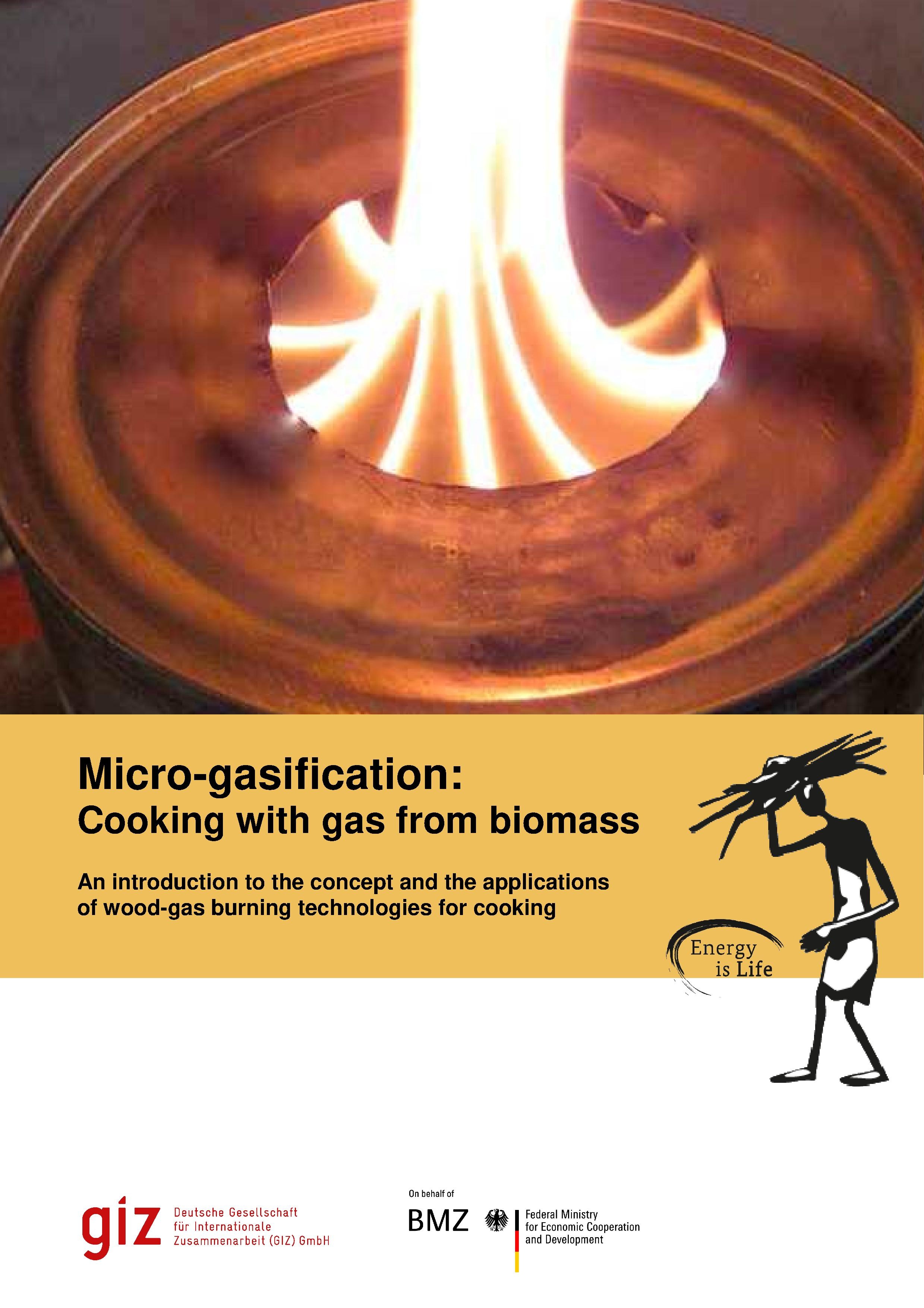 .
.
For more information on the characteristics of firewood as a fuel see also Cooking with Firewood.
The Wood-Fuel Cooking System
As shown in the figure below, in the wood-fuel cooking system, firewood is mixed with air in a reactor. After ignition, a chain reaction is triggered in which heat is generated. This heat is transferred through 3 processes:
Convection: Hot gasses are passing a surface transferring heat into surrounding materials;
Radiation: Red hot embers is radiating heat into surrounding materials;
Conduction: Heat is conducted through materials. Metal is a good heat conductor, whereas air is a poor heat conductor.
The reactor is emitting heat, but also light, gasses and particles. While the emission of heat is wanted, the emission of gasses, particles and light are rather unintended. Good stove designs can reduce the quantity of unwanted emissions in favor of additional heat generation. The heat does not enter automatically into a cooking pot. The design of the heat transfer unit has a big effect on the percentage of the heat transferred into the food to be cooked.
Overall there are two major dimensions for efficiency gains for firewood stoves:
- Achieve complete combustion (=‘create more heat per unit of fuel used’)
- Improve heat transfer (=‘get more heat actually into the pot’)
3-stone Fires or Open Fires
Firewood can be used for cooking even in the absence of a “stove”. Even today, campfires are a popular leisure activity in developed countries.
However, they are not favoured for daily cooking. Some disadvantages of the open fire are:
- Smoke (unburned fuel particles in the air):
The combustion in an open fire tends to be incomplete as oxygen might not reach where it is needed. Low temperatures also contribute to the emission of unburned particles. - Slow pace of cooking:
The cooking pot does not sit in the hottest part of the flames; hence less heat is transferred to the pot than theoretically possible. Even if a lot of heat is generated, the heat is not directed to the cooking pot and heat is lost to the environment. This problem is accelerated if there are windy conditions as the flames are not shielded. - Health risks:
As the flames are not directed or shielded, the cook can easily catch fire when approaching the cooking pot. Sparks pose an additional risk when approaching the fire. Burns are a common effect of open fires. The smoke might also cause eye infections. - High fuel consumption:
The open fire consumes a lot of fuel as (a) not much heat is generated per unit of fuel, (b) only a small proportion of the heat is actually directed to the pot and (c) only a small fraction of the heat that is directed to the pot is actually transferred into the food.
On the other hand, some of these inefficiencies are also welcomed due to their positive side effects:
- Open fires burn slow and do not require frequent attention. This is welcome if other household chores have to be done at the same time.
- Smoke can chase away mosquitoes in malaria-infested areas;
- Smoke can be used to preserve food;
- Open flames emit light, which is welcome before sunrise or after sunset;
- Open fires emit heat, which is welcome in cold areas.
These observations on the open fire can be summarized as follows:
| Parameter |
Advantages | Disadvantages |
|---|---|---|
| Small proportion of heat is directed to the pot; Small proportion of heat is transfered into the food |
Slow cooking allows for other household work to be done at the same time | Slow cooking, Inefficient cooking |
| Emission of smoke (unburned fuel particles) | Repellant for mosquitoes, food preservation | Health risk, Inefficient cooking |
| Emission of heat to the environment | Warming of space in cold areas |
Inefficient cooking |
| Emission of light to the environment | Good vision before dawn or after sunset |
Inefficient cooking |
The development of improved cook stoves is therefore facing a dilemma: the same characteristics are at the same time responsible for both complaints and appreciations of the open fire. There is no solution which can satisfy all the expectations. Any new stove will be a trade-off between different user needs. This dilemma is summarized in the table below.
| Common changes of parameters in improved cook stoves |
Common expectation towards an improved stove |
"Disadvantages” for associated benefits of open fires |
|---|---|---|
Improve efficiency of heat production
|
|
|
|
Improve heat transfer into the cooking pot
|
|
|
Households have to prioritize their needs in order to come up with the decision if an improved cook stove is suitable for them. In areas with fuel scarcity, the need for reduced fuel consumption might be ranked higher than the need for space heating or lighting after dark.
Another strategy can be to provide additional solutions to complement the introduction of the improved cook stoves:
- an extra space heater for the cold season
- a mosquito-repellent net
- a solar lantern for lighting
Stoves for firewood have been developed for over 3000 years. Overviews on types and models have been developed from various entities. Below is just a selection of these:
- UNESCO(1982): Consolidation of information. Cooking stoves Handbook
- GIZ (1995) by Westhoff/German 'Stove Images - a Documentation of Improved and Traditional Stoves in Africa, Asia and Latin America'.
The Aprovecho Institute in Oregon has analysed the design principles which can help to make firewood stoves more fuel-efficient. If all principles are applied, the result would be called a rocket stove, which was invented by Dr. Larry Winiarsky.
-> For further details see www.aprovecho.org.
The Rocket Stove Principle
One of the most successful new concepts in stove design is the rocket stove principle.
- It has a tall combustion chamber which behaves a bit like a chimney; creating more draught than a standard stove. This assists in mixing the air, fuel particles and volatiles, resulting in a hot flame. The internal walls are insulated, reflecting all the heat back into the chamber rather than losing it to the stove body. The insulation keeps everything very hot so that the chemical reaction is more intense, whilst the tall chamber provides more time in which the gases and particles can be burnt completely, giving out all their heat and discharging mainly carbon dioxide and water vapour.
- These hot flue gases pass through a well defined gap between a ‘skirt’, and the pot, as shown in the illustrations given below, resulting in a large percentage of the heat being forced against the sides of the pot, and being transferred to the pot. Where various sizes of pot are used on the same stove, the skirt can be funnel-shaped to accommodate different pots, although some efficiency will be lost.
- An elbow-shaped combustion chamber, with a shelf for the fuel wood, supports the pre-drying of the firewood and allows a controlled, and sufficient, flow of primary air to be warmed as it passes under the wood to the burning wood tips.
| The rocket stove principle. Source: Aprovecho |
Design principles, which can be used more generally include:
- Insulation around the fire and along the entire heat flow path using lightweight, heat resistant materials
- A well-controlled, uniform draught in the burning chamber during the entire combustion process
- Use of a grate or a shelf under the firewood
- Heat transfer maximised by the insertion of the pot into the stove body or using a skirt around the pot.
| A rocket-type stove in action, and showing insulation of the burning chamber, skirt around pot and support frame. Source: GIZ / Aprovecho Institute |
All improved firewood stoves apply at least some of these aspects (listed below) geared toward increasing efficiency and improving heat transfer.
How can we improve the design of the stove to increase the combustion efficiency in a firewood stove?
| Aspect |
How to achieve |
|---|---|
| Increasing the temperature in the combustion chamber (as the burning process is temperature controlled) |
|
| Reduce the intake of firewood | Create a small entrance for the firewood. Then only the required level of wood can be entered. Excess wood cannot be supplied to the reactor |
| Burn off all the volatiles | Allow enough space in the combustion chamber (increasing the space between pot and fire) |
| Adequate air supply | Regulate air and wood intake into the combustion chamber and ensure both the amount of air and wood intake are correlated |
| Reduce the inflow of cold air | Regulate air intake (door) |
| Intake of pre-heated air | Use air as an insulated between an inner and an outer wall of the stove. Air is channeled through this gap before entering the combustion chamber |
| Increasing the draft |
|
| Increase the surface of the wood that is in contact with air |
|
How can we improve the design of the stove to improve the heat transfer in a firewood stove?
| Aspect |
How to Achieve |
|---|---|
| Raise the pot to the highest point of the flames |
|
| Force the hot air to create turbulences on the surface of the cooking pot | Create a small gap between the cooking pot and the pot rest which is big enough not to choke the fire and small enough to mix the air close to the pot. |
| Increase the surface area for the heat transfer |
Create a skirt around the pot which forces the hot air to the walls of the pot. This creates turbulences in the air around the pot surface. |
Application of the Principles
Clay Stove versus a 3-Stone Fire
|
Increased combustion efficiency:
|
|
Improved heat transfer:
|
Quite a number of improved firewood stoves which – like this simple clay stove – adhere to many of the principles mentioned above and deliver some improvements compared to the 3-stone fire. They are an entry point for households into the use of improved cook stoves as they are more affordable than the sophisticated rocket stoves.
Examples are: (see below for Factsheets)
- Chitetezo Mbaula (Malawi)
- Jiko Kisasa (Kenya)
- Tulipe (Benin)
- Anagi stove (Sri Lanka)
- VITA (Mauretanien)
Institutional Stove Compared to an Open Fire
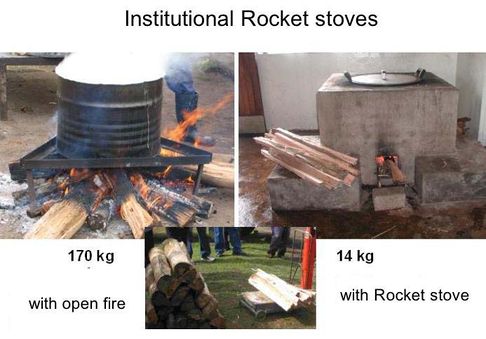
|
Institutional Stove Compared to an open Fire: 40 instead of 170 kg of firewood |
The considerable savings have made institutional rocket stoves very popular among school feeding programmes in Malawi (see also Ashden Award video 2006)
| School feeding programme Mary`s Meals Blantyre, Malawi |
Fixed Stoves
Today most of the GIZ-promoted high-efficiency wood stoves follow this rocket stove principle (see fact sheets for examples):
| MIRT stove for injeera baking Tikikil, Ehtiopia | |||
|
Jiko Kisasa, Kenya (2011) | |||
|
Brick Rocket Stove, Kenya (2011) |
GIZ PSDA Stoves Promotion | ||
|
Two pot mud-rocket Lorena with Air Bypass, Uganda (2011) |
Construction guide from 2008 featuring air-bypass available in English: --> Available in French
| ||
|
Two pot mud-rocket Lorena with shelf, Uganda (2011) | |||
|
One-Pot Shielded Fire Stove with shelf, Uganda (2011) | |||
|
One-Pot Shielded Fire Stove with bypass air inlet, Uganda (2011) | |||
|
Fixed One-Pot Rocket Mud Stove, Benin, Uganda (2011) | |||
| Esperanza stove, Malawi | |||
|
Malawi Institutional Brick Rocket Stove, Malawi (2008) | |||
|
Inkawasi Stoves in Peru (various models adapated for different regions and materials):
| |||
|
Manual Uso y Mantenimiento de la Eco-Estufa Justa, Honduras (2011) | |||
|
Manual Construyendo la Eco-Estufa Justa 16 x 24, Honduras (2011) | |||
Portable Stoves
Efficient, smoke-free cooking with the Rocket Stove:
Further Information
Aprovecho Research Center
For almost 30 years, Aprovecho Research Center (ARC) consultants have been designing and implementing improved biomass cooking and heating technologies in more than 60 countries worldwide. Their website provides a wealth of useful information including construction materials.
Design Tool for Constructing an Institutional Rocket Stove with Chimney
With funding from GIZ HERA, Rocket Stove.org and Prakti Design Lab have developed a new automated tool that allows users to build a customized institutional rocket stove. The tool can be used to design a brick or metal institutional rocket stove with or without chimney for any institutional pot (30 L + capacity).
The stove options for this tool are:
- a fixed brick stove (w/out chimney)
- a portable metal stove with square combustion chamber (w/out chimney)
- a portable metal stove with circular combustion chamber (with chimney)
-> http://www.rocketstove.org/
Rocket Stove Principle
An animation showing the rocket stove principle can be found here.
New Wood Fuel Stove Designs
Two major factors determine if woodfuels burn clean and efficient: its dryness and ventilation. Hence, the right amount of air on the right spot is necessary during the process to ensure a complete combustion.
While it depends on the user to make sure that the fuel is dry, the air-flow depends on the stove design. In a natural draught stove, the movement of air is created by the chimney or stack height of the fuel. However, there must be a difference in temperature between the stove and the top of the chimney to generate draught. Natural draught is likely to cause incomplete combustion with higher emissions and energy losses through the chimney. Moreover, it is also difficult to regulate.
Wood Fuel Stoves with Forced Convection
Instead of naturally ‘pulling’ air through a stove by stack height, fans or blowers are useful to ‘push’ air into the combustion chamber. This enhances a good air-fuel mix and thus, more complete combustion. Electricity is the most convenient power source to create a forced air-flow. It can be provided by batteries or, if available, through the grid. Recently, thermo-electric generators (TEG) have been developed to power fans in stoves. They use the temperature differences within the stove to generate electricity. Though TEGs have great potential to provide power to other applications (LEDs, cell phone charging) as well, they are still in their infancy. Forced convection can reduce emissions of stoves by up to 90 %, thus alleviating IAP levels. More test results from more widespread use are expected soon.
Models Developed by Others
- Stovetec: http://www.stovetec.net/us/stove-models
- Envirofit: http://www.envirofit.org/
- BioLite: http://www.biolitestove.com/Technology.html
References
This article was originally published by GIZ HERA. It is basically based on experiences, lessons learned and information gathered by GIZ cook stove projects. You can find more information about the authors and experts of the original “Cooking Energy Compendium” in the Imprint.


